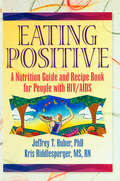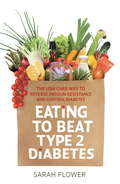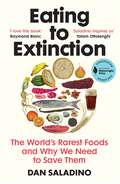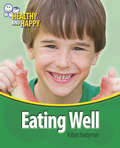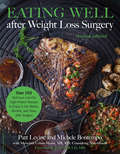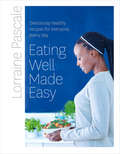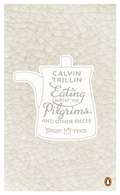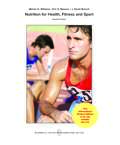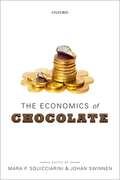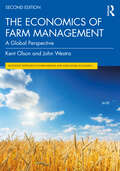- Table View
- List View
Eating Positive: A Nutrition Guide and Recipe Book for People with HIV/AIDS
by Jeffrey T Huber Kris RiddlespergerProper nutrition is essential to individuals with HIV/AIDS. Yet, it is often difficult to maintain an adequate diet due to a variety of conditions associated with the disease and/or medications used to alleviate symptoms. Eating Positive: A Nutrition Guide and Recipe Book for People with HIV/AIDS solves this problem with easy-to-follow, enticing recipes that fit a variety of common diet restrictions and specific health needs of individuals with HIV/AIDS. You can use this practical nutrition guide and recipe book to customize diet plans for your patients or for yourself (with a doctor’s approval) that provide proper nutrition and satisfy the tastebuds.Chapters in Eating Positive are organized by diet type. Each chapter describes the diet type, its benefits and specific restrictions, and actual recipes. Each recipe is accompanied by its respective nutritional values, such as calories, fat, protein, carbohydrates, and percent of daily recommended allowance. An alphabetical index consisting of specific conditions, complications, diet titles, and food stuffs provides ease of use and quick reference. Here is just a sample of some of the many diet types, their benefits, and tasty recipes that are included:Full Liquid Diet: good for people with mouth pain and difficulty chewing as it is easy on the digestive system; recipes include: Orange Cow, Easy Egg Drop Soup, Cherry Dessert, Cottage Cheese Jello Salad, Tropical Frozen Delight, more Fiber Restricted Diet: slows bowel movement and decreases inflammation of the tissues making it a great ally in fighting diarrhea and bowel discomfort; recipes include: Sauteed Cocktail Tomatoes, Bacon Wrapped Chicken Breasts, Vegetarian Stuffed Peppers, Ham Rolls with Eggplant Filling, more Bland Diet: for those who should avoid caffeine, alcohol, spices; recipes include: Raspberry Float, Pasta Salad, Easy Tortellini Soup, One-Eyed Egyptians, Noodle Pudding, Watercress Soup, Sour Cream Coffee Cake, German Potato Dumplings, more High Protein High Calorie Diet: increased calories and nutritional content build up energy resources and assist in improving and maintaining the immune system, stopping and possibly reversing tissue wasting and weight loss and assisting in wound healing; recipes include: Garlic Pasta, Beef and Rice Creole, Spinach Cheese Pie, Tournedos of Beef with Shallot Sauce, Banana Nut Bread, Butterscotch Pie, Pineapple Coconut Cake, many moreThese diets are not prescriptions but rather guides for creating and consuming a practical diet to suit individual needs. You’ll find that Eating Positive puts individuals with HIV/AIDS on the road to a more pleasing, fulfilling, and healthy diet.
Eating Puerto Rico: A History of Food, Culture, and Identity (Latin America in Translation/en Traducción/em Tradução)
by Cruz Miguel Ortíz CuadraAvailable for the first time in English, Cruz Miguel Ortiz Cuadra's magisterial history of the foods and eating habits of Puerto Rico unfolds into an examination of Puerto Rican society from the Spanish conquest to the present. Each chapter is centered on an iconic Puerto Rican foodstuff, from rice and cornmeal to beans, roots, herbs, fish, and meat. Ortiz shows how their production and consumption connects with race, ethnicity, gender, social class, and cultural appropriation in Puerto Rico. Using a multidisciplinary approach and a sweeping array of sources, Ortiz asks whether Puerto Ricans really still are what they ate. Whether judging by a host of social and economic factors--or by the foods once eaten that have now disappeared--Ortiz concludes that the nature of daily life in Puerto Rico has experienced a sea change.
Eating the Enlightenment: Food and the Sciences in Paris, 1670-1760
by E. C. SparyEating the Enlightenment offers a new perspective on the history of food, looking at writings about cuisine, diet, and food chemistry as a key to larger debates over the state of the nation in Old Regime France. Embracing a wide range of authors and scientific or medical practitioners—from physicians and poets to philosophes and playwrights—E. C. Spary demonstrates how public discussions of eating and drinking were used to articulate concerns about the state of civilization versus that of nature, about the effects of consumption upon the identities of individuals and nations, and about the proper form and practice of scholarship. En route, Spary devotes extensive attention to the manufacture, trade, and eating of foods, focusing upon coffee and liqueurs in particular, and also considers controversies over specific issues such as the chemistry of digestion and the nature of alcohol. Familiar figures such as Fontenelle, Diderot, and Rousseau appear alongside little-known individuals from the margins of the world of letters: the draughts-playing café owner Charles Manoury, the “Turkish envoy” Soliman Aga, and the natural philosopher Jacques Gautier d’Agoty. Equally entertaining and enlightening, Eating the Enlightenment will be an original contribution to discussions of the dissemination of knowledge and the nature of scientific authority.
Eating the Enlightenment: Food and the Sciences in Paris, 1670-1760
by E. C. SparyEating the Enlightenment offers a new perspective on the history of food, looking at writings about cuisine, diet, and food chemistry as a key to larger debates over the state of the nation in Old Regime France. Embracing a wide range of authors and scientific or medical practitioners—from physicians and poets to philosophes and playwrights—E. C. Spary demonstrates how public discussions of eating and drinking were used to articulate concerns about the state of civilization versus that of nature, about the effects of consumption upon the identities of individuals and nations, and about the proper form and practice of scholarship. En route, Spary devotes extensive attention to the manufacture, trade, and eating of foods, focusing upon coffee and liqueurs in particular, and also considers controversies over specific issues such as the chemistry of digestion and the nature of alcohol. Familiar figures such as Fontenelle, Diderot, and Rousseau appear alongside little-known individuals from the margins of the world of letters: the draughts-playing café owner Charles Manoury, the “Turkish envoy” Soliman Aga, and the natural philosopher Jacques Gautier d’Agoty. Equally entertaining and enlightening, Eating the Enlightenment will be an original contribution to discussions of the dissemination of knowledge and the nature of scientific authority.
Eating the Enlightenment: Food and the Sciences in Paris, 1670-1760
by E. C. SparyEating the Enlightenment offers a new perspective on the history of food, looking at writings about cuisine, diet, and food chemistry as a key to larger debates over the state of the nation in Old Regime France. Embracing a wide range of authors and scientific or medical practitioners—from physicians and poets to philosophes and playwrights—E. C. Spary demonstrates how public discussions of eating and drinking were used to articulate concerns about the state of civilization versus that of nature, about the effects of consumption upon the identities of individuals and nations, and about the proper form and practice of scholarship. En route, Spary devotes extensive attention to the manufacture, trade, and eating of foods, focusing upon coffee and liqueurs in particular, and also considers controversies over specific issues such as the chemistry of digestion and the nature of alcohol. Familiar figures such as Fontenelle, Diderot, and Rousseau appear alongside little-known individuals from the margins of the world of letters: the draughts-playing café owner Charles Manoury, the “Turkish envoy” Soliman Aga, and the natural philosopher Jacques Gautier d’Agoty. Equally entertaining and enlightening, Eating the Enlightenment will be an original contribution to discussions of the dissemination of knowledge and the nature of scientific authority.
Eating the Enlightenment: Food and the Sciences in Paris, 1670-1760
by E. C. SparyEating the Enlightenment offers a new perspective on the history of food, looking at writings about cuisine, diet, and food chemistry as a key to larger debates over the state of the nation in Old Regime France. Embracing a wide range of authors and scientific or medical practitioners—from physicians and poets to philosophes and playwrights—E. C. Spary demonstrates how public discussions of eating and drinking were used to articulate concerns about the state of civilization versus that of nature, about the effects of consumption upon the identities of individuals and nations, and about the proper form and practice of scholarship. En route, Spary devotes extensive attention to the manufacture, trade, and eating of foods, focusing upon coffee and liqueurs in particular, and also considers controversies over specific issues such as the chemistry of digestion and the nature of alcohol. Familiar figures such as Fontenelle, Diderot, and Rousseau appear alongside little-known individuals from the margins of the world of letters: the draughts-playing café owner Charles Manoury, the “Turkish envoy” Soliman Aga, and the natural philosopher Jacques Gautier d’Agoty. Equally entertaining and enlightening, Eating the Enlightenment will be an original contribution to discussions of the dissemination of knowledge and the nature of scientific authority.
Eating the Enlightenment: Food and the Sciences in Paris, 1670-1760
by E. C. SparyEating the Enlightenment offers a new perspective on the history of food, looking at writings about cuisine, diet, and food chemistry as a key to larger debates over the state of the nation in Old Regime France. Embracing a wide range of authors and scientific or medical practitioners—from physicians and poets to philosophes and playwrights—E. C. Spary demonstrates how public discussions of eating and drinking were used to articulate concerns about the state of civilization versus that of nature, about the effects of consumption upon the identities of individuals and nations, and about the proper form and practice of scholarship. En route, Spary devotes extensive attention to the manufacture, trade, and eating of foods, focusing upon coffee and liqueurs in particular, and also considers controversies over specific issues such as the chemistry of digestion and the nature of alcohol. Familiar figures such as Fontenelle, Diderot, and Rousseau appear alongside little-known individuals from the margins of the world of letters: the draughts-playing café owner Charles Manoury, the “Turkish envoy” Soliman Aga, and the natural philosopher Jacques Gautier d’Agoty. Equally entertaining and enlightening, Eating the Enlightenment will be an original contribution to discussions of the dissemination of knowledge and the nature of scientific authority.
Eating the Enlightenment: Food and the Sciences in Paris, 1670-1760
by E. C. SparyEating the Enlightenment offers a new perspective on the history of food, looking at writings about cuisine, diet, and food chemistry as a key to larger debates over the state of the nation in Old Regime France. Embracing a wide range of authors and scientific or medical practitioners—from physicians and poets to philosophes and playwrights—E. C. Spary demonstrates how public discussions of eating and drinking were used to articulate concerns about the state of civilization versus that of nature, about the effects of consumption upon the identities of individuals and nations, and about the proper form and practice of scholarship. En route, Spary devotes extensive attention to the manufacture, trade, and eating of foods, focusing upon coffee and liqueurs in particular, and also considers controversies over specific issues such as the chemistry of digestion and the nature of alcohol. Familiar figures such as Fontenelle, Diderot, and Rousseau appear alongside little-known individuals from the margins of the world of letters: the draughts-playing café owner Charles Manoury, the “Turkish envoy” Soliman Aga, and the natural philosopher Jacques Gautier d’Agoty. Equally entertaining and enlightening, Eating the Enlightenment will be an original contribution to discussions of the dissemination of knowledge and the nature of scientific authority.
Eating to Beat Type 2 Diabetes: The low carb way to reverse insulin resistance and control diabetes
by Sarah FlowerIn Eating to Beat Type 2 Diabetes, qualified nutritionist and esteemed author Sarah Flower offers a key message for those who either have or are at risk of developing type 2 diabetes: avoid processed grains, sugars and other foods, and opt instead for a balanced diet containing proper ingredients that are rich in natural fats and good-quality protein. Sarah put her own clients suffering from type 2 diabetes onto this sugar-free, low-carb and high-fat regime with amazing results. They experienced weight loss, increased energy levels and - most importantly - they saw their blood sugar levels decrease to a normal range so that they were able to come off medication. This book: -Explains how to make the essential dietary changes to fight type 2 diabetes and the science behind them -Provides a comprehensive 'go-to' list of good and bad foods -Gives practical, easy-to-follow and utterly delicious family recipes which prove that changing your lifestyle and eating habits doesn't have to mean missing out on foods you love - from 'Easy low-carb pancakes' to 'Grain-free chicken Kiev' Eating to Beat Type 2 Diabetes has been supported by Dr David Unwin and Dr Ian Lake. In 2016 Dr Unwin was both 'NHS Innovator of the year' and a finalist for 'Diabetes Team of the Year' in the British Medical Journal National Awards. Dr Ian Lake is medical advisor to diabetes.co.uk and founder member of The Public Health Collaboration, a charity dedicated to informing and implementing health decisions for better public health.
Eating to Extinction: The World’s Rarest Foods and Why We Need to Save Them
by Dan Saladino'This inspiring and urgent book is one of the few food books that has ever given me goosebumps... A story full of both loss and hope.' BEE WILSON'We all need to pay more attention to what we are (and are no longer) eating. Dan Saladino inspires us to believe that turning the tide is still possible.' YOTAM OTTOLENGHI'I love this book... I wish the whole world could read it' RAYMOND BLANC--------------From a tiny crimson pear in the west of England to great chunks of fermented sheep meat in the Faroe Islands, from pistachios in Syria to flat oysters in Denmark, from a wild honey harvested with the help of birds to an exploding corn that might just hold the key to the future of food - these are just some of the thousands of foods around the world today that are at risk of being lost for ever. In this captivating and wide-ranging book, Dan Saladino spans the globe to uncover the stories of these foods. He meets the pioneering farmers, scientists, cooks, food producers and indigenous communities who are preserving food traditions and fighting for change. All human history is woven through these stories, from the first great migrations to the slave trade to the refugee crisis today. But Eating to Extinction is about so much more than preserving the past. It reveals a world at a crisis point: the future of our planet depends on reclaiming genetic biodiversity before it is too late. Eating to Extinction is an astonishing journey through the past, present and future of food, a love letter to the diversity of global food cultures, and a work of great urgency and hope.
Eating Well: Eating Well (Healthy and Happy #4)
by Robyn HardymanThis series introduces the topics of exercise, nutrition, rules for basic safety, the dangers of household products in the home, personal hygiene, common illnesses and disease and making and maintaining healthy relationships. Simple sentence construction and low level words to make the message as simple as possible for 6 to 8 year olds.
Eating Well after Weight Loss Surgery: Over 150 Delicious Low-Fat High-Protein Recipes to Enjoy in the Weeks, Months, and Years after Surgery
by Patt Levine Michelle Bontempo-SarayThe best-selling bariatric cookbook, with more than 125 low-carb, low-fat, high-protein recipes for patients to enjoy after weight-loss surgery.In April 2003 Patt Levine underwent "Lap-Band" gastric surgery, one of the primary bariatric surgeries being widely practiced today. As a lifelong foodie, she was expecting the worst when her surgeon's nutritionist handed her dietary guidelines to follow post-surgery, and she was right. With her decades of cooking skills, she immediately set out to devise low-fat dishes that would be just as delicious pureed and chopped as they would be served whole. As an added problem, she wanted to cook for her husband at the same time. This first-ever cookbook for the hundreds of thousands who are lining up for bariatric bypass surgery is proof that it can be done. With collaborator Michele Bontempo-Saray, the author has created 125 recipes that contain no added sugar, are very low in fat, and get their carbohydrates almost exclusively from fruits and vegetables. Each recipe includes specific guidelines for preparation of the dish for every stage of the eating programs for Lap-Band, gastric bypass, and Biliopancreatric Diversion Duodenal Switch (BPD-DS) patients, as well as suggestions for sharing meals with those who have not gone through gastric surgery. Creative recipes cover every meal and food-breakfast and brunch, soups, vegetables, main courses, and sweet indulgences.
Eating Well after Weight Loss Surgery: Over 150 Delicious Low-Fat High-Protein Recipes to Enjoy in the Weeks, Months, and Years after Surgery
by Patt Levine Michelle Bontempo-SarayThe best-selling bariatric cookbook, with more than 125 low-carb, low-fat, high-protein recipes for patients to enjoy after weight-loss surgery. In April 2003 Patt Levine underwent "Lap-Band" gastric surgery, one of the primary bariatric surgeries being widely practiced today. As a lifelong foodie, she was expecting the worst when her surgeon's nutritionist handed her dietary guidelines to follow post-surgery, and she was right. With her decades of cooking skills, she immediately set out to devise low-fat dishes that would be just as delicious pureed and chopped as they would be served whole. As an added problem, she wanted to cook for her husband at the same time. This first-ever cookbook for the hundreds of thousands who are lining up for bariatric bypass surgery is proof that it can be done. With collaborator Michele Bontempo-Saray, the author has created 125 recipes that contain no added sugar, are very low in fat, and get their carbohydrates almost exclusively from fruits and vegetables. Each recipe includes specific guidelines for preparation of the dish for every stage of the eating programs for Lap-Band, gastric bypass, and Biliopancreatric Diversion Duodenal Switch (BPD-DS) patients, as well as suggestions for sharing meals with those who have not gone through gastric surgery. Creative recipes cover every meal and food-breakfast and brunch, soups, vegetables, main courses, and sweet indulgences.
Eating Well Made Easy: Deliciously Healthy Recipes For Everyone, Every Day
by Lorraine PascaleIt’s everyone’s meal-time dilemma: how to cook quick, easy, tasty meals that are also good for you? Bestselling TV chef Lorraine Pascale’s brilliant new book Eating Well Made Easy shows you how.
Eating Well Made Easy: Deliciously Healthy Recipes For Everyone, Every Day
by Lorraine PascaleIt’s everyone’s meal-time dilemma: how to cook quick, easy, tasty meals that are also good for you? Bestselling TV chef Lorraine Pascale’s brilliant new book Eating Well Made Easy shows you how.
Eating with the Pilgrims and Other Pieces
by Calvin TrillinAcclaimed New Yorker journalist, novelist and poet, Calvin Trillin is also America's funniest and best-loved writer about food. This selection of some of his wittiest articles sees him stalking a peripatetic Chinese chef, campaigning to have the national Thanksgiving dish changed to Spaghetti Carbonara and sampling the legendary Louisiana boudin sausage - to be consumed preferably 'while leaning against a pickup'. Eschewing fancy restaurants in favour of street food and neighbourhood joints, Trillin's writing is a hymn of praise to the Buffalo chicken wing, the deep-fried wonton, the New York bagel and the brilliant, inimitable melting-pot that is US cuisine.
Ebook: Nutrition for Health, Fitness and Sport (UK Higher Education Science & Technology Nutrition)
by Williams AnderEbook: Nutrition for Health, Fitness and Sport
Ecological Medicine 2ND Edition: The antidote to Big Pharma and Fast Foods
by Dr Sarah Myhill Craig RobinsonThis is Dr Sarah Myhill’s comprehensive guide to health care for health practitioners and motivated patients alike – armed with this knowledge, wellness and an optimal health-span should be within our grasp and the grasp of all those we care for.
The Economics of Chocolate
by Johan Swinnen Mara P. SquicciariniThis book, written by global experts, provides a comprehensive and topical analysis on the economics of chocolate. While the main approach is economic analysis, there are important contributions from other disciplines, including psychology, history, government, nutrition, and geography. The chapters are organized around several themes, including the history of cocoa and chocolate — from cocoa drinks in the Maya empire to the growing sales of Belgian chocolates in China; how governments have used cocoa and chocolate as a source of tax revenue and have regulated chocolate (and defined it by law) to protect consumers' health from fraud and industries from competition; how the poor cocoa producers in developing countries are linked through trade and multinational companies with rich consumers in industrialized countries; and how the rise of consumption in emerging markets (China, India, and Africa) is causing a major boom in global demand and prices, and a potential shortage of the world's chocolate.
The Economics of Chocolate
This book, written by global experts, provides a comprehensive and topical analysis on the economics of chocolate. While the main approach is economic analysis, there are important contributions from other disciplines, including psychology, history, government, nutrition, and geography. The chapters are organized around several themes, including the history of cocoa and chocolate — from cocoa drinks in the Maya empire to the growing sales of Belgian chocolates in China; how governments have used cocoa and chocolate as a source of tax revenue and have regulated chocolate (and defined it by law) to protect consumers' health from fraud and industries from competition; how the poor cocoa producers in developing countries are linked through trade and multinational companies with rich consumers in industrialized countries; and how the rise of consumption in emerging markets (China, India, and Africa) is causing a major boom in global demand and prices, and a potential shortage of the world's chocolate.
The Economics of Farm Management: A Global Perspective (Routledge Textbooks in Environmental and Agricultural Economics)
by Kent Olson John WestraFuture farm managers need a range of tools and knowledge to run successful businesses, and this accessible textbook provides the required foundations from economics and management, applied to the farm context. In today’s world where farms are subject to ever-changing industrial, labor, demographic, and technological factors, this textbook provides a clear focus and methodology for business stability and growth. It covers core microeconomic and macroeconomic principles, plus the full range of management topics, from accounting and marketing to operations management and human resource management. It also covers family succession planning and farming mega-trends. This second edition has been updated with the latest data and literature, and gives deeper attention to sustainability and conservation. It also offers a broader range of examples, showcasing the diversity of farm types and farm sizes across the US and globally. Instructor materials are available as digital supplements. This textbook will be a valuable resource for courses in farm management, ranch management, agribusiness, and agricultural economics.
The Economics of Farm Management: A Global Perspective (Routledge Textbooks in Environmental and Agricultural Economics)
by Kent Olson John WestraFuture farm managers need a range of tools and knowledge to run successful businesses, and this accessible textbook provides the required foundations from economics and management, applied to the farm context. In today’s world where farms are subject to ever-changing industrial, labor, demographic, and technological factors, this textbook provides a clear focus and methodology for business stability and growth. It covers core microeconomic and macroeconomic principles, plus the full range of management topics, from accounting and marketing to operations management and human resource management. It also covers family succession planning and farming mega-trends. This second edition has been updated with the latest data and literature, and gives deeper attention to sustainability and conservation. It also offers a broader range of examples, showcasing the diversity of farm types and farm sizes across the US and globally. Instructor materials are available as digital supplements. This textbook will be a valuable resource for courses in farm management, ranch management, agribusiness, and agricultural economics.
Economy Gastronomy: Eat well for less
by Allegra McEvedy Paul MerrettLearn how to eat better and spend less in 2020. 'Delicious, thrifty, inspiring' - Guardian __________ Crammed full of over 100 mouth-watering recipes, creative ideas and practical tips, Economy Gastronomy will help you cook smarter, not harder, and along the way save you a lot of money. You'll learn how easy it is to: - Plan your meals and shrink your food bills - Get two, or even three, meals out of one basic ingredient - Turn leftovers into new and exciting dishes - Stock your cupboards so there's always a meal in the house - Shop seasonally, freeze and store food With hearty breakfasts, tasty lunch-time bites as well as snacks, treats and dinner-party ideas - you'll be making luxurious meals without spending a fortune or discarding surplus food in no time. Recipes include: · CARAMELISED ONION and CHESHIRE CHEESE TART · SEARED SQUID with CHORIZO · SPINACH HAM and RICOTTA GNOCCHI · STICKY PORK RIBS with FIRE AND VINEGAR · CHINESE STYLE CRISPY DUCK · ONION BHAJIS, TARKA DHAL, and ALMOND RICE With Economy Gastronomy you'll learn how to save money without scrimping on flavour.
Ed says U said: Eating Disorder Translator
by June Alexander Catherine SangsterA unique resource of information on eating disorders (EDs), this book aims to improve communication between people with EDs and their loved ones by revealing the ED mind set and decoding language choices. Full of everyday examples, it details the common pitfalls and gives invaluable advice on how best to defuse the triggers.
Eddie Muller's Noir Bar: Cocktails Inspired by the World of Film Noir (Turner Classic Movies)
by Eddie MullerEddie Muller—host of TCM's Noir Alley, one of the world's leading authorities on film noir, and cocktail connoisseur—takes film buffs and drinks enthusiasts alike on a spirited tour through the "dark city" of film noir in this stylish book packed with equal parts great cocktail recipes and noir lore. Eddie Muller's Noir Bar pairs carefully curated classic cocktails and modern noir-inspired libations with behind-the-scenes anecdotes and insights on 50 film noir favorites. Some of the cocktails are drawn directly from the films: If you've seen In a Lonely Place and wondered what&’s in a &“Horse&’s Neck&”—now you&’ll know. If you&’re watching Pickup on South Street you&’ll find out what its director, Sam Fuller, actually drank off-screen. Didn&’t know that Nightmare Alley&’s Joan Blondell inspired a cocktail? It may become a new favorite. Meanwhile, Rita Hayworth is toasted with a "Sailor Beware," an original concoction which, like the film that inspired it (The Lady From Shanghai), is unique, complex, and packs a wallop. Featuring dozens of movie stills, poster art, behind-the-scenes imagery, and stunning cocktail photography, Noir Bar is both a stylish and exciting excursion through classic cinema&’s most popular genre.
